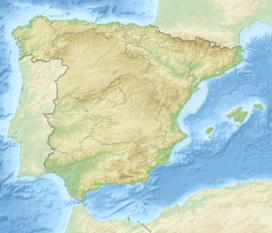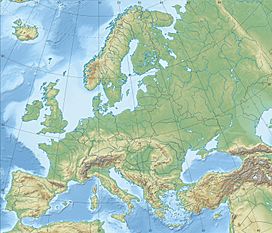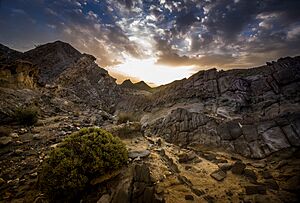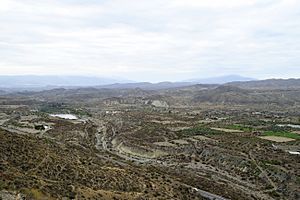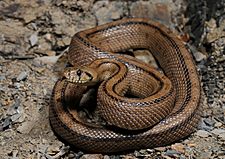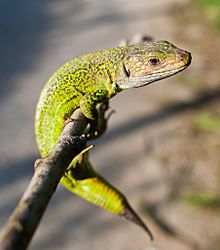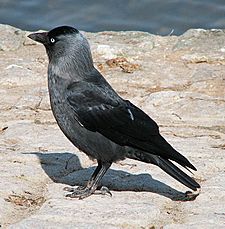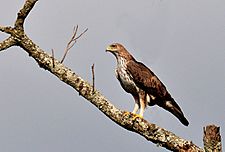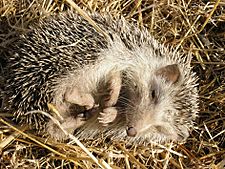Tabernas Desert facts for kids
Quick facts for kids Tabernas Desert |
|
|---|---|
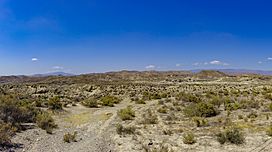
A view of the desert
|
|
| Area | 280 km2 (110 sq mi) |
| Naming | |
| Native name | Error {{native name}}: an IETF language tag as parameter {{{1}}} is required (help) |
| Geography | |
| Country | Spain |
| Autonomous community | Andalusia |
| Province | Almería |
| Population center | Tabernas |
The Tabernas Desert (Spanish: Desierto de Tabernas) is one of Spain's dry deserts. It is found in the southeastern Almería province in Spain. The desert is located inland, about 30 kilometers north of the city of Almería. It is part of the Tabernas municipality in Andalusia.
This desert is a nature reserve, which means it is a protected area. It covers about 280 square kilometers. Because it is high up and far from the coast, it gets a bit more rain than coastal areas. It also has slightly cooler average temperatures each year.
Contents
Climate in Tabernas Desert
The Tabernas Desert has a cold semi-arid climate and a cold desert climate. This means it is mostly dry and can get quite cool. The desert is surrounded by mountains: the Sierra de los Filabres to the north and the Sierra de Alhamilla to the south. These mountains block humid winds from the Mediterranean Sea. This makes the area very dry, a region known as Levante.
In the lowest parts of the Tabernas basin, which are about 400 meters above sea level, the average yearly temperature is around 18.0°C. In winter, temperatures can range from 0°C to 12°C in higher areas. In lower areas, winter temperatures are usually between 6°C and 15°C. Summer temperatures vary from 16°C to 29°C in higher spots and 20°C to 31°C in lower spots.
The desert gets about 15 to 22 centimeters of rain each year. Only about one-third of this rain falls during the hot months, from May to October. The sun shines for about 2900 hours each year.
The climate between 400 and 900 meters is a "Syrian" type of semi-arid climate. This means the driest time of year is during the hottest six months. A special wind called the foehn effect makes this dryness even worse. Above 800 to 900 meters, it rains more, and temperatures drop. At these higher elevations, the climate becomes Mediterranean, not semi-arid.
Geology and Landscape
When it does rain in the Tabernas Desert, the rain is usually very heavy. The ground is made of marls and sandstone and has very little plant life. This means the ground cannot hold much water. Instead, the rain causes erosion, which carves out the unique badlands landscape. These badlands are areas with deeply eroded hills and valleys.
Small streams, called arroyos, form during these heavy rains. These arroyos are where you can find most of the desert's plants and animals.
Plants and Animals of the Desert
The Tabernas Desert has more plants than you might expect for a desert. Some plants, like the sea lavender (Limonium insignis), are very rare and almost extinct. Yet, they manage to grow well in this dry environment. In winter, the desert landscape turns white when the toadflax linaria (Nigricans lange) flowers.
You might also find some interesting creatures here. There are yellow scorpions (Buthus occitanus) and tarantulas (Lycosa tarentulla). There are also black widows (Latrodectus tredecimguttatus), but this type is not as dangerous as the American black widow. Near the coast, you can find small fish called lesser weevers (Echiichthys vipera and Tachinus dracco). These fish usually hide under the sand.
Reptiles and Amphibians
The desert is home to several types of reptiles. These include ladder snakes, spiny-footed lizards, and ocellated lizards. In the wetter parts of the desert, you can find amphibians like marsh frogs, natterjack toads, and terrapins.
Birds of the Desert
Many birds live in the Tabernas Desert. Birds of prey like Bonelli's eagles and peregrine falcons fly high in the sky. Smaller hunters include kestrels and eagle owls. Birds such as the blue rock thrush, rock sparrow, and rock bunting prefer the rocky areas. Other birds like warblers, goldfinches, golden orioles, and serins like the ramblas (dry river beds).
-
A jackdaw
Mammals of the Desert
The Tabernas Desert does not have a huge variety of mammals, with only about 20 different species. Some important mammals living here are the Algerian hedgehog. You can also find many rabbits, hares, and dormouse species.
Tabernas Desert in Movies and TV
The Tabernas Desert looks a lot like deserts in the southwestern United States, northern Mexico, northern Africa, and the Arabian Peninsula. Because of this, it has been a popular place to film movies since the 1950s. Many famous Spaghetti Western movies were shot here. There are three main film studios in the area: Texas Hollywood, Mini Hollywood, and Western Leone.
The desert was also used as a filming location for the sixth season of the TV series Game of Thrones. It was used to represent the Dothraki Sea, a huge grassy plain in the fictional continent of Essos.
See also
 In Spanish: Desierto de Tabernas para niños
In Spanish: Desierto de Tabernas para niños
- Climate of Spain
- List of films shot in Almería
- List of Sites of Community Importance in Andalusia


